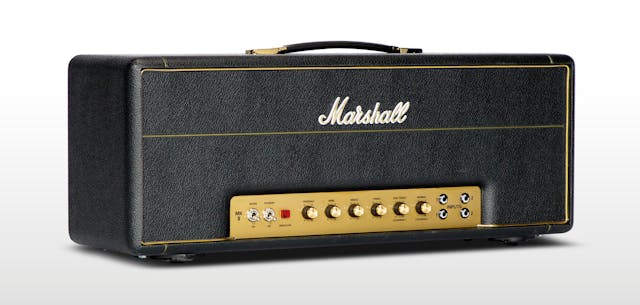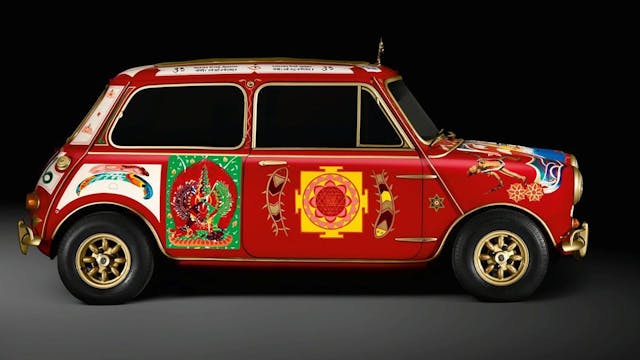Hesitant Fidelity: Are some audio brands a poor fit for automobiles?
Life is full of ironies and seeming contradictions. Leo Fender literally shaped the sound of music for the past 70 years with his companies’ musical instruments and amplifiers, yet he could not play guitar. Neither did he have any formal training in electronics. In another twist, the most influential guitar amplifier ever made—the Fender Bassman—was originally designed by Fender R&D director Freddie Tavares in the late 1950s for the electric bass, not a six-string guitar.
As a matter of fact, bass players think it sounds kind of flabby, but almost every major rock or blues guitarist has used a Bassman or one of its derivatives. Leo may have liked his tone clean, but guitarists discovered that magical things happened to the tone when you turned things up to the point at which the tubes began to distort the signal. A high-fidelity audio system is designed to distort as little as possible, to accurately reproduce the original performance; but when the right guitar amp is overdriven and starts to distort, the combination of even and odd order harmonics, when added to the original signal, makes human ears prick up. Wow, that sounds cool!

The late, great Eddie Van Halen sounded pretty wicked when playing through a Soldano SLO, which Mike Soldano based on the Bassman circuit. Then, in an endorsement deal, EVH switched to the Peavey 5150, which was also derived from the Bassman. Jerry Cantrell, frontman for Alice in Chains, uses Friedman amps. Dave Friedman traces the lineage of his amplifiers back to Tavares’ design. More properly, though, Friedman amps are essentially hot-rodded Marshalls, which were made famous by none other than the coincidentally named James Marshall Hendrix. Jimi played in front of a wall of “Marshall stacks”—a single stack being a 100 watt Marshall Super Lead amplifier sitting atop two 4 x 12 inch speaker cabinets—and is said to have owned as many as 50 Marshall amps. Jimi started playing through Marshalls after former Animals member Chas Chandler discovered him and took him to England, launching his career into the stratosphere.

Jim Marshall was an English drummer who sold musical equipment when he wasn’t gigging. He originally started importing Fender gear but soon realized that he could build similar amps less expensively in the U.K., while avoiding import duties to boot. Because component values for things like resistors and capacitors were not exactly the same in Britain as they were in the United States, Marshall’s recipe had a slightly different flavor of distortion than the Fender original, a flavor that players like Hendrix, the Who’s Pete Townshend, and Cream’s Eric Clapton preferred. Stevie Ray Vaughan had a taste for both, and used both Marshall and Fender Bassman units in his wall of amplifiers.

A half century ago ago, Fender and Marshall were unknown outside the the music business. Today, however, the Fender and Marshall brand names are so widely known that they are being used to market automobiles. The latest example: The recently announced David Brown Automotive Mini Remastered Marshall Edition. The Marshall Edition is a luxuriously fitted original Mini done up to look like a Marshall amplifier, celebrating that brand’s 60th anniversary. You can read all about its black-and-gold Marshall-inspired aesthetics and built-in guitar amplifier over at Hagerty’s U.K. site.

The idea of using guitar brands on car audio originated in a 2013 business ménage à trois comprising Volkswagen, Panasonic, and Fender. The offspring of that pact was audio gear engineered and manufactured by Panasonic installed as OEM equipment in some Volkswagen models … with Fender branding. Fender personnel are described in the publicity materials as consulting with Panasonic on the equipment’s design, but Panasonic has been making high-fidelity audio gear for decades; Fender has no such history. I struggle to envision just what kind of technical advice the Fender folks could have offer to Panasonic.

This wasn’t VW’s first foray into rock ‘n’ roll, either. The Mini Remastered Marshall Edition may be accessorized with a amplifier, but about 15 years ago Volkswagen was marketing its cars as guitar amplifiers. If you bought or leased certain models, you got a free First Act Garage Master electric guitar that came with a built-in, battery-powered preamp that made it possible to play the guitar through the car’s audio system. The Garage Master featured VW logos on the knobs, fingerboard, and neck plate. VW even turned it up to 11, shooting commercials for the guitar promotion with John Meyer, Slash, and Christopher Guest as Nigel Tufnel.

Panasonic and Fender must have thought the deal with VW was worthwhile, because Nissan has begun to offer Fender-branded Panasonic audio gear on some of its contemporary pickup trucks. While I’m sure these cross-marketing tie-ups between car companies and brands associated with rock ‘n’ roll makes some business sense, the partnerships give me the impression that the companies think customers dolts who can be swayed by a familiar logo in an unfamiliar place–even if it doesn’t really make sense.
What makes Fender and Marshall amplifiers treasured by guitar players is their unique distortion, and distortion is exactly what you don’t want from a car audio system. VW, Nissan, and now even little David Brown Automotive, apparently think consumers will be swayed by brands associated with creating music, assuming those brands mean high-quality audio, even though high-fidelity audio is not those brands’ forte.
Now, I’m not naive. Branding of car audio gear has as much (likely, more) to do with marketing as it does with audiophile aspirations. While high-end audio companies like Mark Levinson or B&W may actually be involved in engineering and refining the original equipment car audio systems that bear their names, I’m guessing that about the only investment Dr. Dre has in the factory-installed Beats branded gear in VW Group and Stellantis’ cars is financial. The Marshall Edition Mini’s press release mentions the involvement of Marshall engineers in the car’s development and that the Mini Remastered has an upgraded audio system. It does not, however, say that system was developed by those Marshall engineers.
To paraphrase Queen: Does it really matter? Audiophile snobs may rhyme, “There are no highs, there are no lows, it must be Bose,” but to general consumers the brand Bose means high-fidelity. The Bose Corporation posted $3.2 billion dollars in revenue last year. Most consumers have never listened to true high-end audio gear, so they truly don’t know what they’re missing.

Just don’t express any of the aforesaid cynicism around the companies involved. I may write about cars, but I also happen to have developed an electric harmonica called the Harmonicaster. I’m one of the few people that attend both major auto shows and the NAMM music instrument industry trade shows. That is, except for the folks marketing that Fender-VW-Panasonic hookup, and I can tell you from personal experience that they don’t appreciate even gentle ribbing about Fender audio gear distorting like their guitar amplifiers. “Leo liked clean tone,” they tell me.
In the case of Fender-branded audio gear in cars, that’s doubly annoying, because since Fender doesn’t really sell any consumer audio gear. Marshall, though, has been expanding from guitar amplifiers and effects devices into everyman products like Bluetooth headphones, ear buds, and speakers. My guess is that the Marshall Edition Mini exists to promote those latter offerings. Consequently, there’s a charging port for Marshall headphones in the glove box and a Marshall Bluetooth speaker is stored in the Mini’s boot (trunk, to us colonials) with the guitar amp.
Still, it’s a bit jarring to read that “the pedals feature playful ‘skip track’, ‘pause’ and ‘play’ motifs, another nod to Marshall’s rich heritage.” The graphics may be cute but those of us who know Marshall’s rich heritage know it includes some of the greatest amplifiers and effects pedals ever but not a single cassette, CD, or eight-track tape player.

David Brown Automotive’s luxuriously fitted Mini Remastered series evokes the vintage luxe Radford Minis that Harold Radford’s famed conversion and tuning shop produced back in the 1960s. As a matter of fact, one of the most famous guitarists ever to use Marshall amplifiers, Eric Clapton, briefly owned what is probably the most famous upfitted Mini ever, the psychedelically painted Radford Mini Cooper S belonging to Beatle George Harrison that appeared in the Beatles’ Magical Mystery Tour film.
When Harrison thought he was done with it, he gifted the Mini to his good friend Eric. Like a good friend, though, when George missed his Mini, Clapton returned it in the 1970s. Friendship apparently has its limits, though, as the former Mrs. Harrison, Patty Boyd, Clapton’s muse for Layla, did not return from the guitar virtuoso with the Mini.

With such eager marketers, I’m surprised that someone at David Brown Automotive or Marshall didn’t work out an endorsement deal with Clapton in exchange for a Mini Remastered Marshall Edition. Eric is enough of a car guy that he had Ferrari make him a one-of-one SP12 EC. The companies could have touted that the “Marshall black” paint on the Mini Remastered Marshall Edition matches his most famous guitar, the Fender Stratocaster known as “Blackie.”
Just 60 examples total of the Marshall Mini are being built for the worldwide market (in both LHD and RHD layouts). With a rumored $131,000 price tag, it’s probably a safe bet to say that many of the Mini Remastered Marshall Editions will end up in the collections of folks who already have things like this $43,000 replica of Clapton’s Blackie that Fender’s Custom Shop has painstakingly reproduced.


